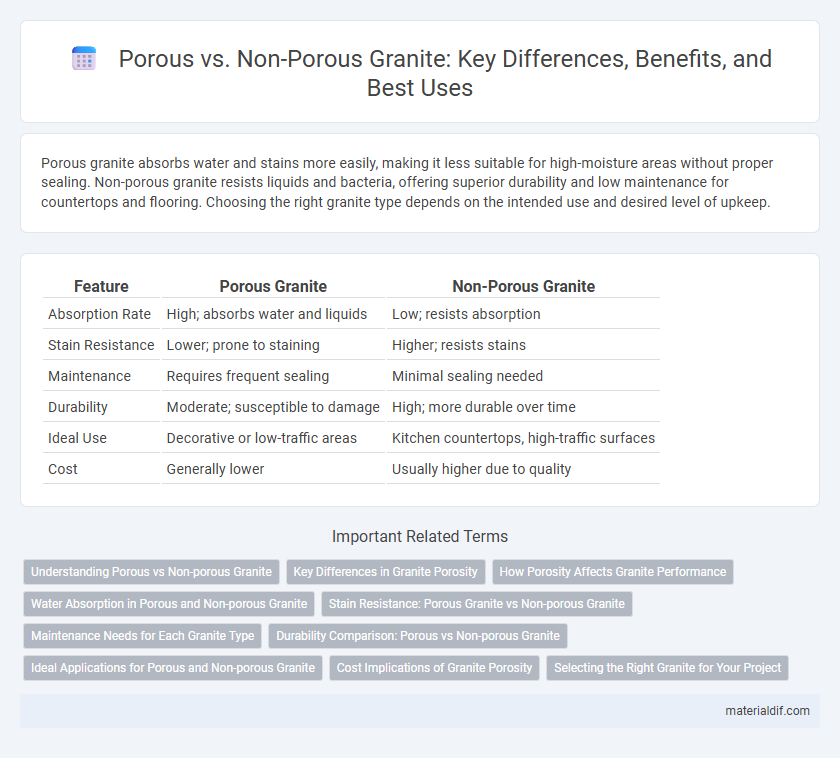Porous granite absorbs water and stains more easily, making it less suitable for high-moisture areas without proper sealing. Non-porous granite resists liquids and bacteria, offering superior durability and low maintenance for countertops and flooring. Choosing the right granite type depends on the intended use and desired level of upkeep.
Table of Comparison
| Feature | Porous Granite | Non-Porous Granite |
|---|---|---|
| Absorption Rate | High; absorbs water and liquids | Low; resists absorption |
| Stain Resistance | Lower; prone to staining | Higher; resists stains |
| Maintenance | Requires frequent sealing | Minimal sealing needed |
| Durability | Moderate; susceptible to damage | High; more durable over time |
| Ideal Use | Decorative or low-traffic areas | Kitchen countertops, high-traffic surfaces |
| Cost | Generally lower | Usually higher due to quality |
Understanding Porous vs Non-porous Granite
Porous granite features microscopic pores that can absorb liquids, making it more susceptible to staining and requiring regular sealing for protection. Non-porous granite has a dense surface that resists moisture penetration, offering enhanced durability and easier maintenance. Understanding these differences helps in selecting granite suited for specific applications like kitchen countertops or outdoor installations.
Key Differences in Granite Porosity
Porous granite contains microscopic holes allowing water and stains to penetrate, making it more susceptible to damage without proper sealing. Non-porous granite has a dense structure that resists absorption, providing enhanced durability and easier maintenance. The porosity level in granite directly influences its stain resistance, longevity, and suitability for various applications such as kitchen countertops or outdoor installations.
How Porosity Affects Granite Performance
Porosity directly impacts granite's durability and maintenance requirements, as porous granite absorbs liquids and stains more easily, making it prone to damage in high-use areas. Non-porous granite offers superior resistance to moisture, bacteria, and staining, enhancing its suitability for kitchens and bathrooms. Understanding porosity levels helps select granite with optimal performance for specific functional environments.
Water Absorption in Porous and Non-porous Granite
Porous granite typically has a higher water absorption rate, ranging from 0.2% to 1.5%, which allows moisture to penetrate its surface, making it more susceptible to stains and damage. Non-porous granite has a much lower water absorption rate, often below 0.1%, providing superior resistance to water infiltration and enhancing durability in wet environments. Proper sealing of porous granite reduces water absorption, improving its functionality and lifespan compared to untreated surfaces.
Stain Resistance: Porous Granite vs Non-porous Granite
Porous granite is more prone to staining because its surface allows liquids to seep into tiny pores, making it essential to apply sealants regularly for protection. Non-porous granite has a dense structure that resists absorption, offering superior stain resistance and easier maintenance without frequent sealing. Choosing non-porous granite is ideal for high-traffic areas prone to spills and stains, ensuring long-lasting durability and a cleaner appearance.
Maintenance Needs for Each Granite Type
Porous granite requires regular sealing and more frequent cleaning to prevent stains and moisture absorption, making its maintenance more intensive. Non-porous granite offers superior resistance to liquids and stains, reducing the need for frequent sealing and simplifying upkeep. Proper maintenance tailored to each granite type ensures durability and preserves the stone's natural appearance over time.
Durability Comparison: Porous vs Non-porous Granite
Non-porous granite exhibits superior durability compared to porous granite due to its low absorption rate, which minimizes the risk of staining and water damage. Porous granite tends to be more susceptible to cracking, discoloration, and wear over time, especially in high-traffic or moisture-prone areas. Selecting non-porous granite enhances longevity and maintains aesthetic appeal with less maintenance and greater resistance to environmental stressors.
Ideal Applications for Porous and Non-porous Granite
Porous granite, with its ability to absorb liquids, is ideal for outdoor applications such as garden pathways and patios where drainage and natural weathering are beneficial. Non-porous granite, resistant to stains and moisture, is best suited for indoor countertops, kitchen surfaces, and bathroom vanities requiring hygiene and easy maintenance. Choosing the right granite type ensures durability and functionality tailored to specific environmental conditions and usage demands.
Cost Implications of Granite Porosity
Porous granite generally incurs higher maintenance costs due to its susceptibility to staining and moisture absorption, requiring regular sealing and cleaning treatments. Non-porous granite, being more resistant to liquids and contaminants, reduces long-term expenses by minimizing the need for protective measures and repairs. Initial purchase prices may be comparable, but total cost of ownership favors non-porous granite due to its durability and lower upkeep requirements.
Selecting the Right Granite for Your Project
Porous granite absorbs liquids and stains more easily, making it less ideal for kitchens or areas prone to spills, while non-porous granite offers superior resistance to moisture and bacteria, ensuring better durability and hygiene. Selecting the right granite involves evaluating the stone's porosity alongside the specific demands of your project, such as exposure to water, frequency of use, and maintenance preferences. Testing granite samples for porosity and consulting with suppliers about sealant requirements can optimize performance and longevity.
Porous Granite vs Non-porous Granite Infographic

 materialdif.com
materialdif.com